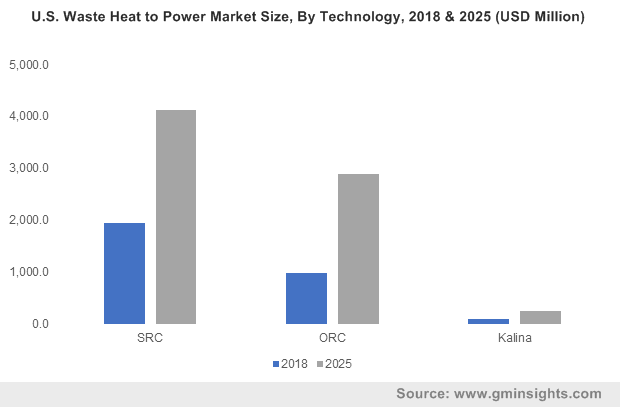U.S. Waste Heat to Power Market to witness remarkable growth over 2017-2024, government initiations toward carbon emission abatement to stimulate the industry landscape
Publisher : Fractovia | Published Date : September 2017Request Sample
Decline in fossil fuel availability has necessitated the requirement of exploring other ways of energy recirculation. Waste heat to power market expansion can be majorly credited to this fundamental aspect. The concept of urbanization and industrialization has always been closely linked with carbon dioxide emissions, a factor that has significantly led to the adoption of low carbon technologies. Waste heat to power market is touted to bring forth latest clean energy solutions that is expected to resolve the alarming issue of energy crisis. While wind and solar energy sources are other economic choices for emission free power generation, waste heat to power technology seems to be a more viable alternative, especially when power generating capacity is concerned. As far as competitive profiling is concerned, investors have been highly optimistic toward the overall waste heat to power market outlook.
U.S. Waste Heat to Power Market Size, By Application, 2016 & 2024 (USD Million)

According to a report put forward by the U.S Environmental Protection Act, in 2012, approximately 6000 MW to 8000MW power can be generated from industrial waste heat at a temperature that is high enough for energy generation. The capability of this technology to convert exhaust heat to power without any catastrophic emission is the most essential factor driving waste heat to power market size. Statistics reaffirming the fact- the overall waste heat to power market is slated to exceed a cumulative capacity of 13 GW by 2024.
The industrial sectors across the globe represent the largest potential source for waste heat to power market share. A substantial amount of energy is wasted as heat in the form of air streams, exhaust gases, and other liquids being discharged from industrial facilities. Estimates claim that almost 20 % to 50% of the input energy gets lost as waste heat. Though it is technically not feasible to recover all the waste heat, today's advanced heat recovery techniques are capable enough to convert a significant portion of this percentage, which would undeniably contribute to the waste heat to power market share. For instance, the industrial sector in U.S. accounts for over 33% of the overall regional energy consumption and can be solely credited for the fossil fuel related GHG emissions, a factor that has significantly impelled the regional waste heat to power market demand.
Waste heat recovery is highly temperature dependent, subject to the fact that the uncovered heat varies with temperature ranges. As per reliable estimations, the amount of waste heat produced in U.S. based industries above 77°F temperature is almost 1478 trillion Btu and it drops to 256 trillion Btu per year if the temperature is elevated to 300°F. Waste heat to power market players are highly emphasizing on research activities with regards to this temperature range to explore the potential heat recovery opportunities. U.S. EIA (Energy Information Administration) in their recent report, claimed that together industrial and commercial sector accounted for almost 4450 trillion Btu energy in 2016. The figure itself is quite a testimony of the huge potential of U.S. waste heat to power market in the coming years.
In fact, numerous American oil & gas and manufacturing enterprises have been already deploying advanced waste heat to power technologies to recover the waste heat generated for electricity generation. Such initiatives are sure to bring additional benefits such as emission free low-cost energy to American mammoths. Furthermore, strict regulatory initiations undertaken by the U.S. EPA (Environmental Protection Agency) with regards to national emission standards would invariably leave an impact on waste heat to power market size.
Other than U.S, Germany is another profound region which has established a strong presence in the waste heat to power market. Strict governmental norms related to carbon emission abatement along with increasing measures toward energy security has stimulated the Germany market outlook. The rising energy consumption of the country has necessitated the demand for waste heat recovery techniques. Statistics by AG Energiebilanzen reports that the energy consumption in Germany had increased by 1.6% in 2016 than what it recorded in 2015. Looking at the present scenario, it is quite overt that Germany waste heat to power market is slated to witness a profitable path in the coming years, with a target installed capacity of 800 MW by 2024.
Renowned biggies involved in waste heat to power market have been increasingly investing in advanced technologies and new product launches in sync with customers demand to experience an expanded consumer base. For instance, America based power generation giant, Echogen Power Systems had launched a customized heat engine system (EPS 100) in 2014, focusing on the environmental and energy requirements across power generation, oil & gas, and marine sectors. Some of the other prominent players include Thermax, Siemens, Triogen, ElectraTherm, Mitsubish, ABB, Amec Foster Wheeler, and AQYLON. Considering the proliferation of technology across the global energy matrix, it can be quite aptly quoted that waste heat to power market will generate quite a heavy momentum in the renewable energy space. Attesting to the same, Global Market Insights Inc., forecasts the global waste heat to power market share to exceed a valuation of USD 30 billion by 2024.